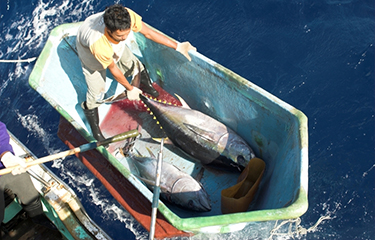Despite the People’s Republic of China maintaining that mainland China and Taiwan are parts of “One China” whose sovereignty cannot be divided, the world's second-largest economy appears reluctant to entertain such perceptions when it comes to the management of fisheries for both entities.
The country’s delegation to the Indian Ocean Tuna Commission (IOTC) has disagreed with the commission’s 10,557 metric ton (MT) yellowfin tuna catch-limit for 2022, saying the figure is below the 15,339 MT it expected. The higher quota is based on catch limits being calculated separately for mainland China and Taiwan.
“Based on the long-standing practice at IOTC, the yellowfin tuna catch limits for the People Republic of China in 2022 shall be 15,339 MT (4,641 MT for the mainland China and 10,688 MT for Taiwan), and not 10,557 [MT],” said a letter to the IOTC from Jiangfeng Zhu, China’s commissioner to the IOTC.
The 2022 catch limit is part of a larger plan by the IOTC to rebuild the Indian Ocean yellowfin tuna stock within the commission’s area of control, a key goal of IOTC Resolution 21/01, which came into effect on 17 December, 2021.
Zhu said China can’t agree with the reasoning that the IOTC used to calculate the country’s yellowfin tuna catch limit. China is expecting the two countries to be considered differently, because the standards are different depending on the catch volume of the country – since Taiwan is below a threshold and China is above it, they should be treated differently, Zhu said.
“We understand that it is a long-standing practice of IOTC to separate the tuna catch from fleet of the mainland China and Taiwan Province of China,” Zhu said.
IOTC Executive Secretary Chris O’Brien confirmed in an email to SeafoodSource that the 10,557 MT allocated for 2022 for China “includes Taiwan, Province of China.”
He said IOTC Resolution 21/01 “requires the catch limits to be calculated and reported by CPC [cooperating noncontracting party].” China is one of the 30 CPCs in the IOTC.
O’Brien said, for now, “the commission has not been asked to address China’s disagreement with the calculation.”
The IOTC’s calculation of the catch limits followed the advice of the commission’s scientific committee, although the circular announcing the 2022 catch limits clarified yellowfin tuna volumes for the CPCs “are provisional because 2021 catch data, which are used to calculate the 2022 catch limits, are not available until June 2022 for all gears, except longline, and December 2022 for longline.”
“For this reason, 2021 catch levels are assumed to be the same as those taken in 2020,” IOTC’s previous statement said.
Japan, which in 2013 signed a deal with Taiwan to allow the latter to fish within 19 kilometers of the disputed Japanese-controlled Senkaku islands (known as the Diaoyu islands in China) has supported the position taken by China on the 2022 yellowfin tuna catch limits.
“As pointed out by China, the IOTC has been managing catches of China and Taiwan, Province of China separately and catch limits for yellowfin tuna established by Resolution 16/01 and succeeding Resolution 21/01 have been applied separately to China and Taiwan, Province of China,” Hideki Moronuki, Japan’s commissioner to the IOTC, said in a statement.
At the 25th session of the commission, there were no objections to allocating China and Taiwan’s allocation differently, Moronuki said.
"It is naturally considered that the commission agreed to manage catch limits for China and Taiwan, Province of China separately," Moronuki said.
In 2021, the IOTC allocated Taiwan’s longline fleet 11,057 MT, 10 percent less than the 12,285 MT allocated in 2014 – the year used as a baseline for calculating yellowfin tuna quota for countries catching in excess of 5,000 MT of tuna.
China’s concerns on yellowfin tuna catch limits come five months after both China and Taiwan were listed on a NOAA report as countries engaging in illegal, unreported, and unregulated (IUU) fishing.
Photo courtesy of Simon Buxton/WWF







